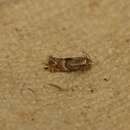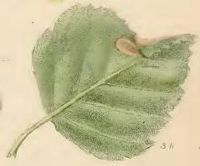tr
kırıntılardaki isimler


Phyllonorycter ulmifoliella ist eine Miniermotte aus der Unterfamilie Lithocolletinae. Die Art wurde von dem Entomologen Jacob Hübner im Jahr 1817 als Tinea ulmifoliella erstbeschrieben.[1] Das lateinische Art-Epitheton ulmifoliella bezieht sich auf Ulmen-Blätter, wobei Ulmen nicht zu den Raupennahrungspflanzen gehören.
Die Falter von Phyllonorycter ulmifoliella besitzen eine Flügelspannweite von 7–9 mm.[2] Der Kopf ist goldbraun gefärbt, das Gesicht weiß. Die Fühler sind an der Spitze weiß. Die Vorderflügel besitzen eine goldbraune Grundfärbung. Ein vorne dunkel gerandeter weißer Mittelstreifen führt von der Basis bis etwa 2/5 der Flügellänge. Etwa auf 1/3 Länge befindet sich ein diffuser weißer dorsaler Randfleck. Ferner weisen die Vorderflügel einen etwas gewinkelten quer verlaufender Medianstreifen, drei Rippen am Vorderrand sowie zwei dreieckige weiße Flecke am Hinterrand auf, alle vorne dunkel gerandet. Nahe dem Apex befindet sich ein schwarzer punktförmiger Fleck. Die Hinterflügel sind dunkelgrau gefärbt.
Die bis zu 5 mm langen gelbgrünen Raupen besitzen eine grünlich-graue Rückenlinie. Auf der Oberseite des sechsten Hinterleibssegmentes befindet sich gewöhnlich ein orange-gelber Fleck.[3][4] Die Kopfkapsel ist blassbraun.
Phyllonorycter ulmifoliella ist in Europa weit verbreitet. Ihr Vorkommen reicht von Fennoskandinavien und den Britischen Inseln im Norden bis in den Mittelmeerraum. Auf der Iberischen Halbinsel fehlt die Art offenbar.[1] Im Osten reicht das Vorkommen bis in den Fernen Osten (Japan). Die Miniermotten findet man fast überall, wo Birken wachsen.
Die Art bildet zwei Generationen pro Jahr.[2] Die Falter der ersten Generation beobachtet man gewöhnlich im Mai, die der Sommergeneration im August.[2] Entsprechend treten die Raupen im Juli sowie im Herbst von September bis November auf.[5] Die Überwinterung findet im Puppenstadium statt.[5] Die Wirtspflanzen der Miniermottenart bilden verschiedene Birken (Betula). Zu diesen zählen die Hänge-Birke (Betula pendula), die Moorbirke (Betual pubescens), die Zierkirschen-Birke (Betula grossa) sowie Betula x alpestris.[5] Die Raupen leben in einer Faltenmine in einem Blatt ihrer Wirtspflanze. Dabei ziehen die Seidenfäden der Raupe die Mine auf der Blattunterseite zwischen zwei benachbarten Blattadern zusammen.[6] Dadurch wölbt sich das Blatt leicht. Es wird nur die untere Epidermis gefressen, so dass das Blatt von oben betrachtet undurchsichtig bleibt.[6][3] Die Minen erreichen Längen von 10–15 mm.[3] Die Kotkügelchen der Raupen werden in einer Ecke der Mine gelagert.[3] Die Verpuppung findet innerhalb der Mine statt. Die Raupen der Sommergeneration spinnen lediglich einen dünnen Kokon, während die überwinternde Generation einen stabilen Kokon spinnt.
Es werden eine Reihe von Parasitoide genannt. Aus der Erzwespen-Familie Eulophidae sind dies:[3][4]
Weitere Parasitoide sind folgende Brackwespen:[3]
Außerdem gehören folgende Schlupfwespen zu den Parasitoiden von Phyllonorycter ulmifoliella:[3]
Phyllonorycter ulmifoliella ist eine Miniermotte aus der Unterfamilie Lithocolletinae. Die Art wurde von dem Entomologen Jacob Hübner im Jahr 1817 als Tinea ulmifoliella erstbeschrieben. Das lateinische Art-Epitheton ulmifoliella bezieht sich auf Ulmen-Blätter, wobei Ulmen nicht zu den Raupennahrungspflanzen gehören.
Phyllonorycter ulmifoliella is a moth of the family Gracillariidae. It is found in all of Europe (except the Iberian Peninsula and the Balkan Peninsula), east to Russia and Japan.
The wingspan is 7–9 mm. The head is golden-brownish, face white. Antennae with apex white. Forewings golden brownish; a shining white median streak from base to 2/5, dark margined above; an ill defined white dorsal spot at 1/3; a somewhat angulated median fascia, three posterior costal and two dorsal triangular spots shining white, anteriorly dark margined; a black apical dot. Hindwings are rather dark grey. The larva is yellow-green; dorsal line greenish-grey; head pale brown.[2]
There are two generations per year with adults on wing in May and again in August.[3]
The larvae feed on Betula x alpestris, Betula grossa, Betula pendula and Betula pubescens. They mine the leaves of their host plant. They create a small lower surface tentiform mine. The lower epidermis is greenish-yellow and weakly folded. Pupation takes place within the mine in a cocoon. The frass is deposited in a corner of the mine.[4]
Phyllonorycter ulmifoliella is a moth of the family Gracillariidae. It is found in all of Europe (except the Iberian Peninsula and the Balkan Peninsula), east to Russia and Japan.
 Phyllonorycter ulmifoliella, Llandegla moor, North Wales
Phyllonorycter ulmifoliella, Llandegla moor, North Wales  Mined birch leaf
Mined birch leaf The wingspan is 7–9 mm. The head is golden-brownish, face white. Antennae with apex white. Forewings golden brownish; a shining white median streak from base to 2/5, dark margined above; an ill defined white dorsal spot at 1/3; a somewhat angulated median fascia, three posterior costal and two dorsal triangular spots shining white, anteriorly dark margined; a black apical dot. Hindwings are rather dark grey. The larva is yellow-green; dorsal line greenish-grey; head pale brown.
There are two generations per year with adults on wing in May and again in August.
The larvae feed on Betula x alpestris, Betula grossa, Betula pendula and Betula pubescens. They mine the leaves of their host plant. They create a small lower surface tentiform mine. The lower epidermis is greenish-yellow and weakly folded. Pupation takes place within the mine in a cocoon. The frass is deposited in a corner of the mine.
De berkenvouwmot (Phyllonorycter ulmifoliella) is een vlinder uit de familie mineermotten (Gracillariidae). De wetenschappelijke naam is voor het eerst geldig gepubliceerd in 1817 door Hübner.
De soort komt voor in Europa.
Bronnen, noten en/of referentiesPhyllonorycter ulmifoliella là một loài bướm đêm thuộc họ Gracillariidae. Nó được tìm thấy ở khắp châu Âu ngoại trừ Iberian Peninsula và the bán đảo Balkan.
Sải cánh dài 7–9 mm. Có hai lứa trưởng thành vào tháng 5 và một lần nữa vào tháng 8.[2]
Ấu trùng ăn Betula x alpestris, Betula grossa, Betula pendula và Betula pubescens. Chúng ăn lá nơi chúng làm tổ. They create a small lower surface tentiform mine. The lower epidermis is greenish-yellow và weakly folded. Pupation takes place withtrong mine in a cocoon. The frass is deposited in a corner of the mine.[3]
Phyllonorycter ulmifoliella là một loài bướm đêm thuộc họ Gracillariidae. Nó được tìm thấy ở khắp châu Âu ngoại trừ Iberian Peninsula và the bán đảo Balkan.
Sải cánh dài 7–9 mm. Có hai lứa trưởng thành vào tháng 5 và một lần nữa vào tháng 8.
Ấu trùng ăn Betula x alpestris, Betula grossa, Betula pendula và Betula pubescens. Chúng ăn lá nơi chúng làm tổ. They create a small lower surface tentiform mine. The lower epidermis is greenish-yellow và weakly folded. Pupation takes place withtrong mine in a cocoon. The frass is deposited in a corner of the mine.